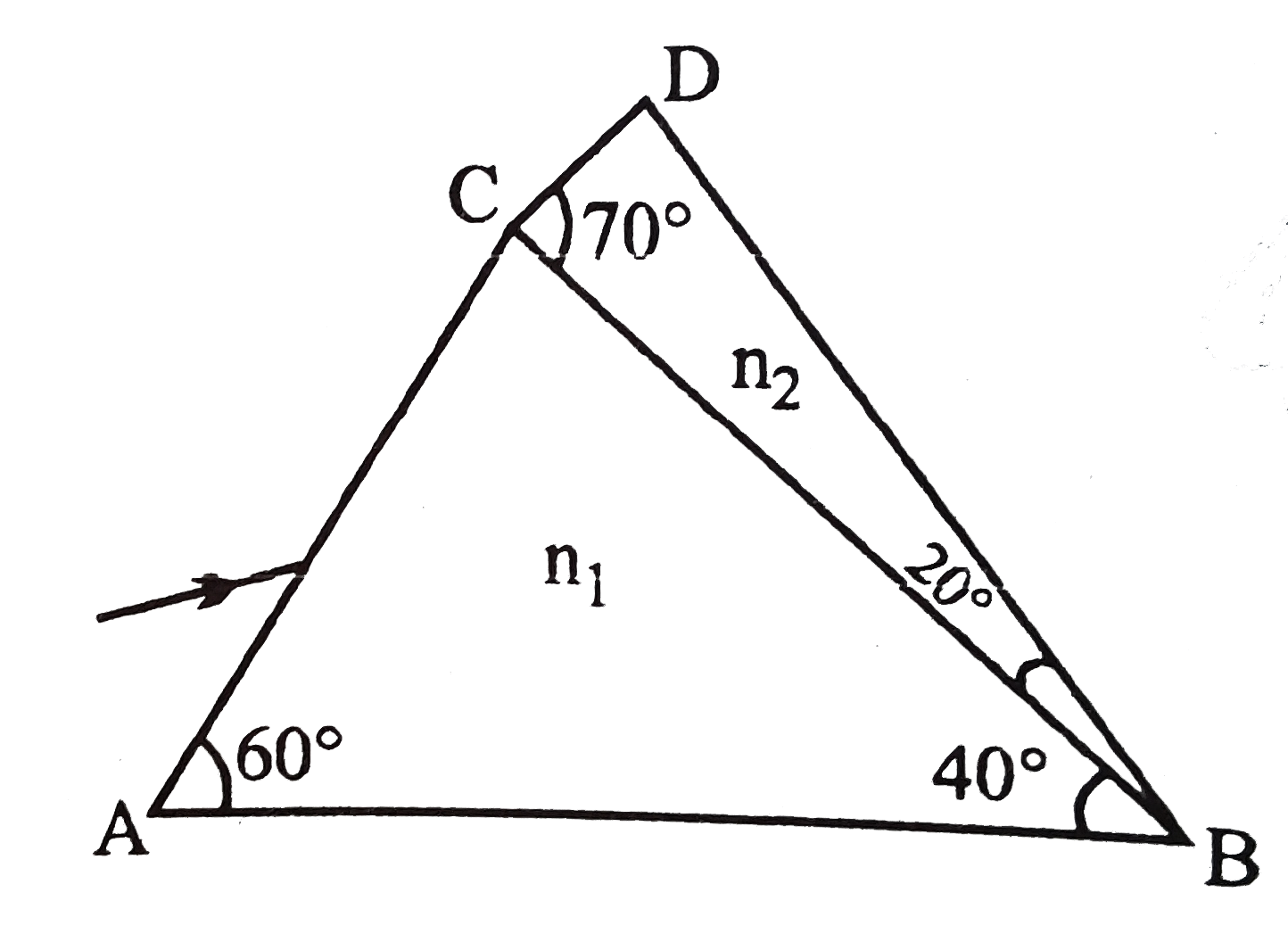A planet of radius R=110×(radiusofEarth) has the same mass density as Earth. Scientists dig a well of depthR5 on it and lower a wire of the same length and a linear mass density 10−3kgm(_1) into it. If the wire is not touching anywhere, the force applied at the top of the wire by a person holding it inplace is (take the radius of Earth=6×106m and the acceleration due to gravity on Earth is 10ms−2Solution in Gujrati
96 N
108 N
120 N
150 N
The correct Answer is:B
EG=4πGrρ3
dF=EGλdr
F=R∫4R54πGρλ3rdr=4πGρλ3[r22]R4R5
=4πGρλ3×2[R2−16R225]=4π6Gρλ×925R2
F=4π6G×M4π3R3e×λ×925×R2e100
After solving [F⇒108N]
Topper's Solved these Questions
- GRAVITATIONBOOK - ALLEN CHAPTER - GRAVITATIONEXERCISE - Illustration
34 Videos
- GRAVITATIONBOOK - ALLEN CHAPTER - GRAVITATIONEXERCISE - BOX-1
3 Videos
- GRAVITATIONBOOK - ALLEN CHAPTER - GRAVITATIONEXERCISE - Exercise 5 A (Previous Year Questions)
26 Videos
- GEOMETRICAL OPTICSBOOK - ALLEN CHAPTER - GEOMETRICAL OPTICSEXERCISE - subjective
14 Videos
- KINEMATICS-2DBOOK - ALLEN CHAPTER - KINEMATICS-2DEXERCISE - Exercise (O-2)
47 Videos
Similar Questions
Two spherical balls of mass 10 kg each are placed 100 m apart. Find the fraviational force of attraction between them.
View SolutionIf four different masses m1,m2,m3 and m4 are placed at the four corners of a square of side a, the resultant gravitational force on a mass m kept at the centre is
View SolutionIf suddenly the gravitational force of attraction between earth and satellite revolving around it becomes zero, then the satellite will
View SolutionA prism of refractive index n1 & another prism of reactive index n2 are stuck together without a gap as shown in the figure.The angle of the prisms are as shown. n1&n2depend onλ,the wavelength of light according to n1=1.20+10.8×104λ2&n2=1.45+1.80×104λ2 where λ is in nm.

(i)Calculate the wavelength λ0for which rays incident at any angle on the interfaceBCpass through without bending at that interface.
(ii) for light of wavelength λ0,find the angle of incidencei on faceACsuch that the deviation produced by the combination of prism is minimum.
View SolutionA particle is moving in xy-plane .At certain instant the components of its velocity and acceleration are as follows ux=3m/s,uy=4m/s,ax=2m/s2anday=1m/s2. The rate of change of speed at this moment is
View SolutionA planet of radius R=(1)/(10)xx(radius of Earth) has the same mass density as Earth. Scientists dig a well of depth (R )/(5) on it and lower a wire of the same length and a linear mass density 10^(-3) kg m(_1) into it. If the wire is not touching anywhere, the force applied at the top of the wire by a person holding it inplace is (take the radius of Earth =6xx10^6m and the acceleration due to gravity on Earth is 10ms^(-2)
View SolutionA force F is applied on the wire of radius r and length L and change in the length of wire is l . If the same force F is applied on the wire of the same material and radius 2r and length 2L. Then the change in length of the other wire is
View SolutionThe dimensional formula for force per unit linear mass density of wire is the same as that for :
View Solutionपृथ्वी के समान द्रव्यमान घनत्व वाले एक गृह की त्रिज्या R=110× (पृथ्वी की त्रिज्या) है। वैज्ञानिक इस ग्रह में R5 गहराई वाला एक कुआँ खोदते है और इसमें उतनी ही लम्बाई तथा 10−3 किग्रा मी−1 रेखीय द्रव्यमान घनत्व वाला एक तार डालते है, जो कुँए को कही भी स्पर्श नहीं करता है। तार को पकडकर यथास्थान रखने के लिये एक व्यक्ति द्वारा लगाया गया बल है। (उपयोगी सुचना : पृथ्वी की त्रिज्या =6×106 मीटर तथा पृथ्वी की सतत पर गुरुत्वीय त्वरण 10 मी से−2)
View SolutionIf M=mass of wire, ρ=density of wire, R=radius of wire, r=change in radius, L=original length of wire and l=change in length, then poisson's ratio is given by
View Solutionरेखीय द्रव्यमान घनत्व 5.0×10−3kg/m वाला एक तार 50 N के तनाव से खींचा हुआ है और किनारों पर स्थिर अवस्था में रखा हुआ है । यह तार 420 Hz की आवृत्ति पर तथा उसके बाद 490Hz की आवृत्ति पर अनुनाद करता है । तार की लंबाई निकालें ।
View SolutionThe ratio of the weight of a body on the Earth’s surface to that on the surface of a planet is 9 : 4. The mass of the planet is 19 of that of the Earth. If ‘R’ is the radius of the Earth, then the radius of the planet is where n is ___________ . (Take the planets to have the same mass density)
View Solution0.45kg द्रव्यमान के तार का प्रतिरोध 0.014Ω है। यदि तार के पदार्थ की प्रतिरोधक 1.78×10−7Ω−m हो तो इसकी लम्बाई एवं त्रिज्या की गणना कीजिए। तार के पदार्थ का घनत्व 8.93×103kgm−3 है।
View SolutionCalculate the radius of the earth if the density of the earth is equal to the density of the nucleus. [mass of earth 5.97×1024kg].
View SolutionIf the escape velocity of a planet is 3 times that of the earth and its radius is 4 times that of the earth, then the mass of the planet is (Mass of the earth = 6×1024kg)
View Solutionपृथ्वी के समान द्रव्यमान घनत्व वाले एक ग्रह की त्रिज्या R=110× (पृथ्वी की त्रिज्या) है। वैज्ञानिक इस ग्रह में R5 गहराई वाला एक कुँआ खोदते हैं और इसमें उतनी ही लम्बाई तथा 10−3kgm−1 रेखीय द्रव्यमान घनत्व वाला एक तार डालते हैं, जो कुँए को कहीं भी स्पर्श नहीं करता है। तार को पकड़कर यथास्थान रखने के लिये एक व्यक्ति द्वारा लगाया गया बल है (उपयोगी सूचना : पृथ्वी की त्रिज्या =6×106m तथा पृथ्वी की सतह पर गुरूत्वीय त्वरण, g=10ms−2 )
View Solution
